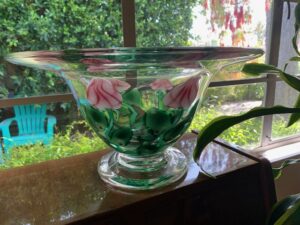 I’ve known many kinds of artists in my career. Perhaps the most inventive and eccentric artists by MEDIUM are glassblowers. I don’t know if it’s something to do with the heat, the long deep breaths of air down a punty rod, or the fickle nature of glass. But I consider a glass artist a wizard, a shaman, a technician, an engineer, and a creator. Glass is one of the mysteries of life as it’s NOT a solid, but a liquid…so I am told. This expensive medium will soon become a lost art. While glass sells cheaply out of countries other than the US, American glasswork faces a challenging future.
I’ve known many kinds of artists in my career. Perhaps the most inventive and eccentric artists by MEDIUM are glassblowers. I don’t know if it’s something to do with the heat, the long deep breaths of air down a punty rod, or the fickle nature of glass. But I consider a glass artist a wizard, a shaman, a technician, an engineer, and a creator. Glass is one of the mysteries of life as it’s NOT a solid, but a liquid…so I am told. This expensive medium will soon become a lost art. While glass sells cheaply out of countries other than the US, American glasswork faces a challenging future.
ED sent me a lovely 1980s sixteen-inch diameter glass bowl signed Vandermark and numbered in an edition. The edition number means only a certain number were blown out of three hundred. An etched signature on the foot reads ‘Steven Smarr.’ Some research indicates Smarr blew glass with Douglas Merritt in New Jersey in the late 1990s. Doug still lectures on glass, so I contacted him about this bowl.
Making Glass the ‘Old School’ Way
A talented group of artists who came out of the studio of Gerald Vandermark (born in the 1940s) studied how to make glass the “old school” way. Doug and other students of Vandermark learned Colonial glassmaking techniques. They worked, like their mentor, at national parks and historic manor museums, where glassblowing became part of the Colonial Craft Village Experience. Vandermark, in 1959, worked at the Colonial glasshouse at Jamestown National Park, and his students also worked for various Colonial villages. In fact, Vandermark Studios was known for Colonial reproduction glassware beginning in 1972. The studio soon developed a unique style in contemporary art glass.
Merritt and Smarr made glass together at the Creative Glass Center of Millville NJ. Artists there developed a following in traditional glass art techniques, both as teachers and creators of fine glass in styles:
- cameo glass, like Galle and Daum
- cased glass, layering of different colors of glass blown in sequence
- layered glass, cut down to a colored base layer
- feathered glass, Tiffany style peacock
- flashed glass, think of Aurene/Tiffany
Merritt developed a technique called Diatretta. We see it on this large bowl, where the pink and green floral design appears “in the round” having weight and dimensions.
American Art Glass Deservedly Famous
If you get a chance to visit the Corning Glass Museum in upstate New York, you’ll see some wonderful American glass, past and present. Look for Merritt’s piece in that museum, a work of cameo glass, a technique made popular in France in the early 1900s.
Vandermark Merritt Studios, a fixture in New Jersey for forty-four years, shutdown their furnace in 2016. Doug Merritt now teaches. That brings me back to how glassblowers are a special breed of artist. The act of making glass takes a definite physical toll on the artist’s body. If you consider how much breath it takes to make a vessel, the heat of the furnace, and the danger of the work, you will agree.
Vandermark Merritt Studios “came up” through the American Colonial glassmaking tradition. Their students performed those costumed demos at such places as Sturbridge, Colonial Williamsburg, and Jamestown. The “old School” glassblowers knew how to build a furnace and their own glassmaking tools. They knew how to melt their own glass, not just to order glass pellets from Amazon. They also knew that glass artistry was the ultimate challenge, as glass can tease and trick, according to Merritt.
Vandermark Merritt glass is in the collection of the MET, the Toledo Museum, the Chrysler Museum, the Corning Museum of American Glass, The Wheaton Museum of American Glass, the Smithsonian, Boston Museum, Philadelphia Museum, Newark Museum, Sturbridge, and Colonial Williamsburg. The MET chose Douglas Merritt to blow glass globes for the Renaissance Revival Room of their American Wing. He made reproductions of the fancy glass globes for a late 19th century chandelier.
ED’s bowl new goes for $3,000, but similar ones sell for $800.
Yes I have many great works from Steve Smarr, as he was married to my sister Mary up until his untimely death at the young age of 52. He was such a talented glass blower! We stopped down at his shop in Branchburg on readington road to observe his talent a few times. It was by pretty amazing.